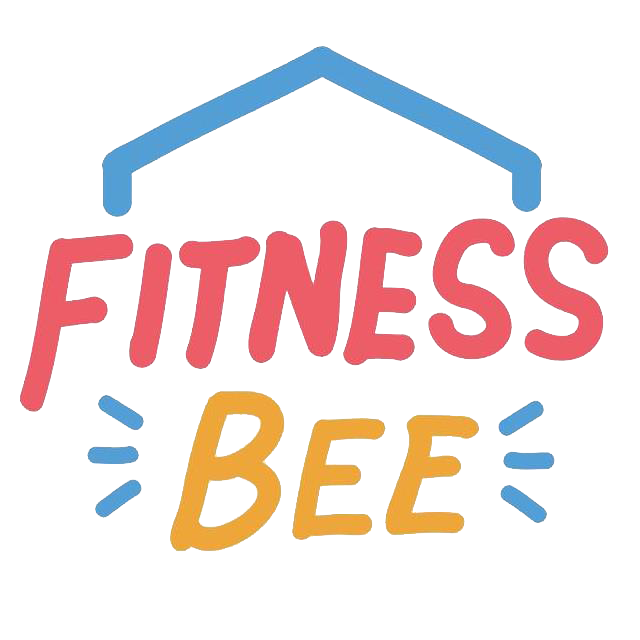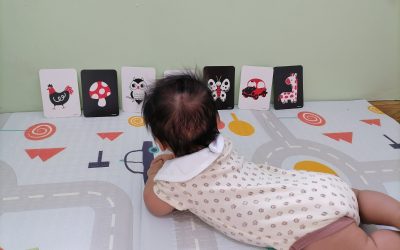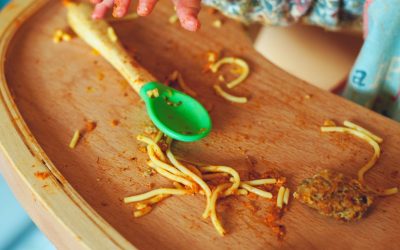WHAT IS BABY-LED WEANING?
Baby-Led Weaning or BLW, simply defined, is an approach to feeding where we allow our babies to feed themselves age-appropriate solid food as opposed to us adults spoon feeding them. Through this approach, we let our babies take the lead during the feeding process and empower them to have more control over what they want or do not want to take in. Research shows that this approach allows babies to be more independent, confident eaters who are less likely to be picky eaters and more aware of their fullness or hunger sensations. Baby-led weaning lets babies self-feed by making them use their hands to learn about their food and bring it to their mouths whenever they are ready. Meal preparation encourages us to veer away from the traditional purees and mashed food as the sole type of baby food. Instead, BLW promotes giving babies modified versions of our adult food and cutting them into pieces that are safe for the baby to self-feed.
BLW AND THE SENSES
As a Pediatric Occupational therapist momma, BLW held so much more meaning to me than just the act of eating to satisfy hunger. It is actually a whole new different level of sensory experience for babies. Letting children touch and explore different textures and temperature of food, getting food smeared around their lips and cheeks, and allowing them to engage in messy play promotes the following:
- Body awareness – Understanding the different parts of the body and where they are located. It’s like allowing your brain to understand a map of your own body so you know how to use them eventually. This helps a lot in gross, fine, and oral-motor development in babies and children.
- Ability to tolerate different food textures, temperatures, and tastes – By letting babies have a feel of the food with their hands first, they get an idea of what it is that they are going to eventually put into their mouths.
- Language skills – allows babies to understand what is sweet, sour, rough, smooth, hot or cold, and so much more.
HOW DO WE START?
It’s important to know when your child is ready to start with solids. Some would say to start solids as soon as your baby turns 6 months. Ideally, though, you should also wait for other signs of readiness such as:
- Stable head and neck, showing good control and can sustain upright position
- Ability to sit independently (though not necessarily for a long time)
- Showing interest towards food, reaching towards food or opening mouth when food is offered
If your baby is already 6 months but has not shown the rest of the readiness signs, I suggest you hold off on solids to avoid instances of choking.
For me and my son, we started with a lot of sensory play, touching both food and non-food items to expose him to different textures and temperatures. We did water play, and I also let him play with fruit and vegetable peels (with close supervision to avoid mouthing!). We also did regular tummy time to work on improving his head and neck control, shoulder strength, trunk stability, and coordination. During mealtimes, my husband and I would make sure to bring him with us to the table so he can watch us eat. Soon, he was more than ready to join us for meals!
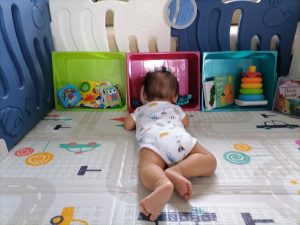
Tummy time strengthens babies head, neck, shoulders, and trunk.
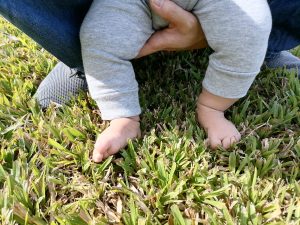
Sensory play by letting my baby’s feet touch the grass
WHAT TO EXPECT
For the first few weeks, don’t expect your baby to eat anything much! Solids for them at this point is just for the experience and practice. Your little one is just learning how to eat. Breastmilk and/or formula should still be the primary source of your baby’s nutrition up until 12 months of age. With this in mind, try to relax and just let your baby explore. If your baby ends up eating a few bites, then well and good! If he finishes the serving and wants more, go ahead and give him more! If he doesn’t seem to like the dish, you can always offer it again next time. What’s important at this stage is to allow your baby to see, smell, and feel the food without pressure. We want baby to look forward to mealtimes and enjoy the sensory experience he gets every time he sits at the dinner table.

First day of solids at 6 months: mashed avocado with breastmilk Given a pre-loaded spoon for him to self-feed Also allowed to use bare hands to scoop food and bring to mouth (and hair lol!)
As weeks turn to months, your baby will eventually get the hang of things and start feeding more efficiently. Still, whenever you introduce something new, try not to impose it on your child. Instead, give him some time to look, smell, and feel the new food item until he is ready to give it a taste.

Solids at 8 months: Steamed fish, sauteed bokchoy chopped finely, and dragon fruit cut into wedges
BLW VERSUS TRADITIONAL FEEDING
Compared to BLW where the Baby takes the lead, traditional spoon feeding is mainly directed by the adult feeder. This is preferred by a lot of caregivers as this ensures that:
- Baby takes in more food.
- There is less spillage and mess.
- Clean up is a breeze.
However, traditional spoon feeding strips off the child’s autonomy during feeding.
- Forces baby to take “just 1 more bite” even if he is already full
- Limits baby’s sensory exploration of the food item before it is placed into his mouth
- Prevents the child from using his hands to feed self, thus not able to practice important fine motor skills for feeding (e.g. tripod/pincer grasp, coordination of bringing hand to mouth, etc)
BLW, on the other hand, promotes better independence in feeding and promotes a confident, happy eater. Still, I think we all agree that the biggest downside of baby-led weaning is the huge MESS that baby makes while eating! HERE’s what I did to contain all the mess and make cleaning up quick and easy. I’d also love to show you some of the items I found useful during my BLW journey with my son.
Mealtimes are always a highlight in our family’s everyday living. Now with a happy and confident little eater excited to participate in mealtimes, it has become a much more meaningful daily occupation we all participate in. Want to work on your baby’s sensory-motor skills to improve feeding? You may want to take a look at our year round Play Academy classes & 1 on 1 Coaching programs.
At Fitness Bee, we offer periodic Play Academy toddler classes. Here, we incorporate a lot of fun and active games and exercises to strengthen muscle groups necessary for feeding.
Sensory play exploration is also a highlight in these classes. You can expect a variety of movement, deep pressure, and tactile-rich activities to help improve your child’s body awareness, gross and fine motor skills.
If you want a more personalized sensory, motor, and self-care intervention for your child, our Occupational therapists (OTs) can help! We also offer 1 on 1 coaching programs especially developed to assess and enhance your child’s skills through fun, play-based, and age-appropriate goal-oriented activities.
Want to help improve your little one’s motor skills at home? Check out my blog on Tummy Time for Babies to learn specific tips and activity suggestions on how to do this important baby exercise.
